 Front cover of The Great Khan Game boxed set | |
| Genre | Role-playing game |
|---|---|
| Publisher | TSR, Inc. |
| Media type | Boxed set |
The Great Khan Game is a fantasy board game that was published by TSR, Inc in 1989.
 Front cover of The Great Khan Game boxed set | |
| Genre | Role-playing game |
|---|---|
| Publisher | TSR, Inc. |
| Media type | Boxed set |
The Great Khan Game is a fantasy board game that was published by TSR, Inc in 1989.
The Great Khan Game is a game about acquiring countries, by gathering the various rulers and important people of the lands. [1]
This card-and-board game humorously presents the epic sweep of politics, trade, and warfare, among budding fantasy empires. Peoples and rabble join with heroes and leaders to form nations intent on the economic, political, and military conquest of the known world. [2]
The game is described in the sourcebook Forgotten Realms Adventures : "This is a whimsical board/card game of conquest and intrigue set in the Whamite Isles, several tiny specks of land in the Sea of Fallen Stars. Players try to direct the fortunes of nations to amass the most power before the Historian draws events to a close." [3]
Players gather melds (groups of cards representing leaders and peoples), into rich and powerful nations that vie for control of territories on a map. To win, a player must control the most territory and have the richest treasury at the end of the game. The game offers various ways to gain gold (trade with and conquest of other nations, for example) and to gain control of nations and territory, usually by war (battles between melds of cards representing nations) and political coups (in which a nation changes hands when a competitor plays a more powerful meld than the existing meld representing a given country). As players draw cards each turn, new leaders and peoples come into play and event cards signal disasters (assassins, rare diseases, earthquakes, and peasant revolts) and windfalls (trade caravans, fleets, and philanthropists) for the competing nations. [2]
The Great Khan Game is a folio boxed game with a 32-page rulebook, a game map, 162 playing cards and counters. [2]
The game was designed and illustrated by Tom Wham with Richard Hamblen; the game map and playing cards were designed by Jeff Dee and Amanda Dee. [2]
In the July 1989 edition of Games International (Issue 7), James Wallis was a bit put off by the price, which was significantly more than TSR's previously published Tom Wham game, Mertwig's Maze . He found that The Great Khan Game was based on "a very simple and playable idea," but he felt that the basic idea had been lost because "the designers seem to have wanted to expand it into a wargame." He called the complex combat system with its numerous variables "a daft idea," and felt there were "other unnecessary twiddly bits which obstruct the game rather than adding to it." Wallis concluded by giving the game a below-average rating of 2 out of 5, saying "The Great Khan Game is [...] playable and perhaps enjoyable, but without question has a number of complex and unnecessary elements [...] By all means buy [it], especially if you're willing to do some work to unearth the good game that lies beneath, but as it stands, I cannot recommend it." [4]
In the April 1991 edition of Dragon (Issue 168), Ken Rolston noted the game's "goofy, cheerful tone and play style" with "Vividly characterized fantasy peoples and rabble", noting that the game "neatly combines epic scale and mock-epic tone in simultaneously exploiting and parodying the most distinctive excesses of the grand-fantasy genre setting". He said the game "boasts Tom Wham's light touch, simple and readable rules, and a vivid, imaginative fantasy setting focusing on the personalities, virtues, and foibles of various creatures, heroes, and stooges". Rolston considered the game's artwork "spartan and modest", and called the illustrations "cute, lovable, and perfectly in keeping with the tone of the game". He noted that game "is sold unblushingly as an Advanced Dungeons & Dragons Forgotten Realms product, despite no discernible relationship to the AD&D game or the Realms. This lapse in marketing taste is excusable only because anyone who looks at the game box can tell immediately that its tone and style have nothing to do with either the Realms or the FRPG." Although he was confused by the rules from time to time, he found it to be "well play-tested", indicated by the thoughtful remarks on play within the rules. Rolston added, "the informal tone and style of rules writing invites you not to take the rules too seriously. Only someone who misunderstood the intent of a Tom Wham game could get involved in a rules squabble." He concluded the review by saying: "The Great Khan Game is a pleasant, light-hearted fantasy game with an excellent flavor and an enjoyable, pleasing play style. Its competitive, diplomatic elements are nicely balanced by a mock-epic tone, and the epic conflicts of fantasy kingdoms play out like a grand, profoundly cheesy fantasy novel." [2]
Forgotten Realms is a campaign setting for the Dungeons & Dragons (D&D) fantasy role-playing game. Commonly referred to by players and game designers alike as "The Realms", it was created by game designer Ed Greenwood around 1967 as a setting for his childhood stories. Several years later, Greenwood brought the setting to publication for the D&D game as a series of magazine articles, and the first Realms game products were released in 1987. Role-playing game products have been produced for the setting ever since, as have various licensed products including novels, role-playing video game adaptations, comic books, and the film Dungeons & Dragons: Honor Among Thieves.

Mystara is a campaign setting for the Dungeons & Dragons fantasy role playing game. It was the default setting for the "Basic" version of the game throughout the 1980s and 1990s. Most adventures published for the "Basic" edition of D&D take place in "The Known World", a central continent that includes a varied patchwork of both human and non-human realms. The human realms are based on various real-world historical cultures. In addition, unlike other D&D settings, Mystara had ascended immortal beings instead of gods.
Faerûn is a fictional continent and the primary setting of the Dungeons & Dragons world of Forgotten Realms. It is described in detail in several editions of the Forgotten Realms Campaign Setting with the most recent being the 5th edition from Wizards of the Coast, and various locales and aspects are described in more depth in separate campaign setting books. Around a hundred novels and several computer and video games use Faerûn as the setting.

Ravenloft is an adventure module for the Dungeons & Dragons (D&D) fantasy role-playing game. The American game publishing company TSR, Inc. released it as a standalone adventure booklet in 1983 for use with the first edition Advanced Dungeons & Dragons game. It was written by Tracy and Laura Hickman, and includes art by Clyde Caldwell with maps by David Sutherland III. The plot of Ravenloft focuses on the villain Strahd von Zarovich, a vampire who pines for his lost love. Various story elements, including Strahd's motivation and the locations of magical weapons, are randomly determined by drawing cards. The player characters attempt to defeat Strahd and, if successful, the adventure ends.
Abeir-Toril is the fictional planet that makes up the Forgotten RealmsDungeons & Dragons campaign setting, as well as the Al-Qadim and Maztica campaign settings, and the 1st edition version of the Oriental Adventures campaign setting.
Tom Wham is a designer of board games who has also produced artwork, including that for his own games.
An owlbear is a fictional creature originally created for the Dungeons & Dragons fantasy role-playing game. An owlbear is depicted as a cross between a bear and an owl, which "hugs" like a bear and attacks with its beak. Inspired by a plastic toy made in Hong Kong, Gary Gygax created the owlbear and introduced the creature to the game in the 1975 Greyhawk supplement; the creature has since appeared in every subsequent edition of the game. Owlbears, or similar beasts, also appear in several other fantasy role-playing games, video games and other media.

H1 Bloodstone Pass is an adventure module for the first edition of the Advanced Dungeons & Dragons (D&D) fantasy role-playing game. It was written by Douglas Niles and Michael Dobson and published by TSR, Inc., in 1985. While it contained some traditional D&D elements, the main portion of the module was a series of mass battles using the D&D Battlesystem.
The flexibility of the Dungeons & Dragons (D&D) game rules means that Dungeon Masters (DM) are free to create their own fantasy campaign settings. For those who wanted a pre-packaged setting in which to play, TSR, Wizards of the Coast (WotC), and other publishers have created many settings in which D&D games can be based; of these, the Forgotten Realms, an epic fantasy world, has been one of the most successful and critically acclaimed settings. Many campaign settings include standard sword and sorcery environments, while others borrow Asian, Central American, swashbuckling, horror and even space-travel themes.
Wiz-War is a 4-player board game created by Tom Jolly and first published in 1985 through Jolly’s company, Jolly Games. It is described as a "beer and pretzels game".
James M. Ward is an American game designer and fantasy author who worked for TSR, Inc. for more than 20 years.
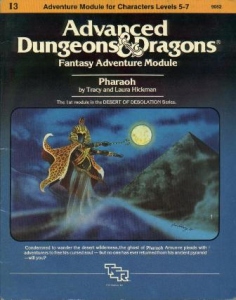
Desert of Desolation is a compilation adventure module published by TSR for the Dungeons & Dragons (D&D) fantasy roleplaying game. It combines three previously published individual modules: Pharaoh, Oasis of the White Palm, and Lost Tomb of Martek. The modules were made for use with the first edition Advanced Dungeons & Dragons (AD&D) rules. Pharaoh was created by Tracy and Laura Hickman soon after the couple married in 1977, and published by TSR in 1982. Oasis of the White Palm was a collaboration between Tracy Hickman and Philip Meyers, and Hickman wrote the Lost Tomb of Martek on his own; both were printed in 1983.
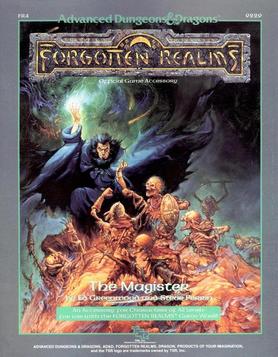
The Magister is an accessory for the Forgotten Realms campaign setting of the first edition Advanced Dungeons & Dragons fantasy role-playing game. The book, with product code TSR 9229, was published in 1988 by TSR. It was written by Ed Greenwood and Steve Perrin, with cover art by Jeff Easley and interior art by Valerie Valusek.
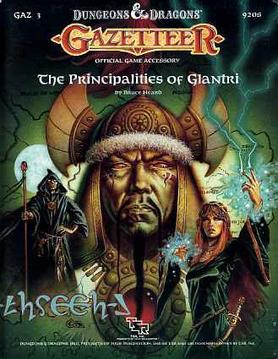
The Principalities of Glantri is an accessory for the Basic Set edition of the Dungeons & Dragons fantasy role-playing game. It is part of the Gazetteer series of supplements for the Mystara campaign setting.
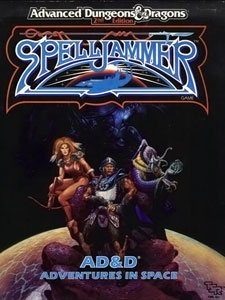
Spelljammer: AD&D Adventures in Space is a 1989 boxed set accessory for the Spelljammer campaign setting, part of the Advanced Dungeons & Dragons fantasy role-playing game. It supplies rules and materials for playing AD&D in space. The set was well received by critics and fans.
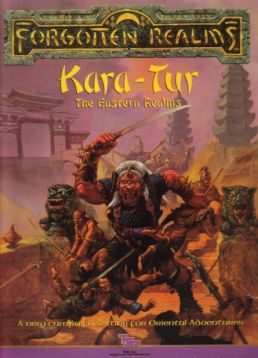
Kara-Tur: The Eastern Realms is an accessory and campaign setting for the Advanced Dungeons & Dragons fantasy role-playing game.
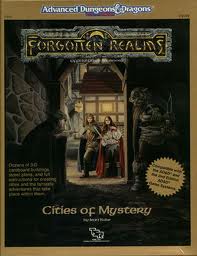
Cities of Mystery is an accessory for the Advanced Dungeons & Dragons fantasy role-playing game. It is a system for designing urban adventure settings, written by Jean Rabe and published by TSR in 1989. Along with a book and maps, the box set contains 33 full-color card stock model buildings. The book received mixed reviews from Dragon magazine, although the 3-D buildings and fold-out street layouts were highly praised.
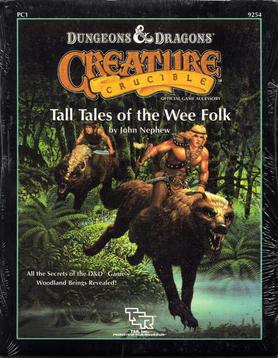
Tall Tales of the Wee Folk is an accessory for the Dungeons & Dragons fantasy role-playing game.
Mertwig's Maze is a fantasy board game for 2–9 players designed and illustrated by Tom Wham and published by TSR in 1988.
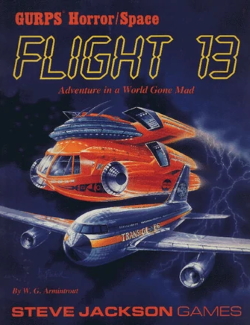
Flight 13 is an adventure published by Steve Jackson Games in 1989 for either the horror role-playing game GURPS Horror or the science fiction role-playing game GURPS Space.